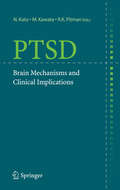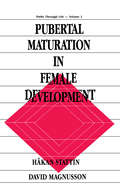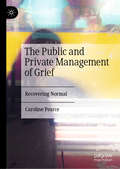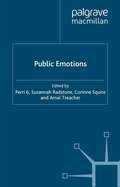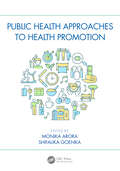- Table View
- List View
Psycurity: Colonialism, Paranoia, and the War on Imagination (Concepts for Critical Psychology)
by Rachel Jane LiebertAcross the world, the rhetoric and violence of white supremacy is rising up. Yet, explanations for white supremacist attacks typically direct attention toward an unreasonable, paranoid state of mind, and away from the neocolonial security state that made them. Offering a response to US expressions of white supremacy, Liebert reads paranoia as a dis-ease of coloniality by following its circulation within the ultimate place of reason, indeed a key arbitrator of it: Psychology. Through reflexivity, interviews, participant observation, scientific artefacts, and public art, this unique work seeks to argue for and experiment with unsettling the entwined coloniality of Psychology and the current political moment, joining with struggles for a world where it is not only white lives that matter. Tracing the spinning cogs and affective coils of the prodromal movement – a program of research that, capturing potential psychosis, illustrates the serpentine workings of a control society – Liebert argues that, within a context of psycurity, paranoia hides as reasonable suspicion, predicts the future, brands threatening bodies, and grows through fear, thereby seeping into the cracks of white supremacy, stabilizing it. Catching this argument as itself enacting psycurity, she then engages the more-than-human to search for paranoia’s decolonizing, otherworldly potential; one that may revive the psykhe – breath – of psychologies too. Calling for psychologies to leave Psychology’s comfort zone and make space for imagination, this performative, interdisciplinary work will engage students, researchers, and activists from an array of disciplines who wish to examine a critical and creative response to present-day racism and fascism.
Psycurity: Colonialism, Paranoia, and the War on Imagination (Concepts for Critical Psychology)
by Rachel Jane LiebertAcross the world, the rhetoric and violence of white supremacy is rising up. Yet, explanations for white supremacist attacks typically direct attention toward an unreasonable, paranoid state of mind, and away from the neocolonial security state that made them. Offering a response to US expressions of white supremacy, Liebert reads paranoia as a dis-ease of coloniality by following its circulation within the ultimate place of reason, indeed a key arbitrator of it: Psychology. Through reflexivity, interviews, participant observation, scientific artefacts, and public art, this unique work seeks to argue for and experiment with unsettling the entwined coloniality of Psychology and the current political moment, joining with struggles for a world where it is not only white lives that matter. Tracing the spinning cogs and affective coils of the prodromal movement – a program of research that, capturing potential psychosis, illustrates the serpentine workings of a control society – Liebert argues that, within a context of psycurity, paranoia hides as reasonable suspicion, predicts the future, brands threatening bodies, and grows through fear, thereby seeping into the cracks of white supremacy, stabilizing it. Catching this argument as itself enacting psycurity, she then engages the more-than-human to search for paranoia’s decolonizing, otherworldly potential; one that may revive the psykhe – breath – of psychologies too. Calling for psychologies to leave Psychology’s comfort zone and make space for imagination, this performative, interdisciplinary work will engage students, researchers, and activists from an array of disciplines who wish to examine a critical and creative response to present-day racism and fascism.
PsyQM: Qualitätsmanagement für psychotherapeutische Praxen
by Beatrice PiechottaDas für Psychotherapeuten noch ungewohnte Thema anschaulich, nachvollziehbar und umsetzbar aufbereitet! Seit Januar 2006 ist die Qualitätsmanagement-Richtlinie des Gemeinsamen Bundesausschusses in Kraft: Jede psychotherapeutische Praxis muss ein QM-System einführen und weiterentwickeln. Beatrice Piechotta, niedergelassene Psychotherapeutin und QM-Expertin, stellt mit PsyQM ein System speziell für psychotherapeutische Praxen vor.QM in Theorie und PraxisFür kleine und große Praxisgemeinschaften: QM so schlank wie möglich und so umfangreich wie es die gesetzlichen Auflagen erfordernQM in der verhaltenstherapeutischen, der tiefenpsychologischen und der psychoanalytischen PraxisQM angepasst an die realen Abläufe in der psychotherapeutischen PraxisInklusive QM-HandbuchViele Beispiele machen QM anschaulich: So wird die praktische Umsetzung konkretArbeitsblätter, Checklisten und Anleitungen zur Erstellung von Infomaterialien
PTSD: A Short History (Johns Hopkins Biographies of Disease)
by Allan V. HorwitzPost-traumatic stress disorder;¢;‚¬;€?and its predecessor diagnoses, including soldier;€™s heart, railroad spine, and shell shock;¢;‚¬;€?was recognized as a psychiatric disorder in the latter part of the nineteenth century. The psychic impacts of train crashes, wars, and sexual shocks among children first drew psychiatric attention. Later, enormous numbers of soldiers suffering from battlefield traumas returned from the world wars. It was not until the 1980s that PTSD became a formal diagnosis, in part to recognize the intense psychic suffering of Vietnam War veterans and women with trauma-related personality disorders. PTSD now occupies a dominant place in not only the mental health professions but also major social institutions and mainstream culture, making it the signature mental disorder of the early twenty-first century. In PTSD, Allan V. Horwitz traces the fluctuations in definitions of and responses to traumatic psychic conditions. Arguing that PTSD, perhaps more than any other diagnostic category, is a lens for showing major historical changes in conceptions of mental illness, he surveys the conditions most likely to produce traumas, the results of those traumas, and how to evaluate the claims of trauma victims. Illuminating a number of central issues about psychic disturbances more generally;¢;‚¬;€?including the relative importance of external stressors and internal vulnerabilities in causing mental illness, the benefits and costs of mental illness labels, and the influence of gender on expressions of mental disturbance;¢;‚¬;€?PTSD is a compact yet comprehensive survey. The book will appeal to diverse audiences, including the educated public, students across the psychological and social sciences, and trauma victims who are interested in socio-historical approaches to their condition.Praise for Allan V. Horwitz;€™s Anxiety: A Short History"The definitive overview of the history of anxiety.";¢;‚¬;€?Bulletin of the History of Medicine"A lucid, erudite and brisk intellectual history driven by a clear and persuasive central argument.";¢;‚¬;€?Social History of Medicine"An enlightening tour of anxiety, set at a sensible pace, with an exceptional scholar and writer leading the way.";¢;‚¬;€?Library Journal
PTSD: A Short History (Johns Hopkins Biographies of Disease)
by Allan V. HorwitzPost-traumatic stress disorder;¢;‚¬;€?and its predecessor diagnoses, including soldier;€™s heart, railroad spine, and shell shock;¢;‚¬;€?was recognized as a psychiatric disorder in the latter part of the nineteenth century. The psychic impacts of train crashes, wars, and sexual shocks among children first drew psychiatric attention. Later, enormous numbers of soldiers suffering from battlefield traumas returned from the world wars. It was not until the 1980s that PTSD became a formal diagnosis, in part to recognize the intense psychic suffering of Vietnam War veterans and women with trauma-related personality disorders. PTSD now occupies a dominant place in not only the mental health professions but also major social institutions and mainstream culture, making it the signature mental disorder of the early twenty-first century. In PTSD, Allan V. Horwitz traces the fluctuations in definitions of and responses to traumatic psychic conditions. Arguing that PTSD, perhaps more than any other diagnostic category, is a lens for showing major historical changes in conceptions of mental illness, he surveys the conditions most likely to produce traumas, the results of those traumas, and how to evaluate the claims of trauma victims. Illuminating a number of central issues about psychic disturbances more generally;¢;‚¬;€?including the relative importance of external stressors and internal vulnerabilities in causing mental illness, the benefits and costs of mental illness labels, and the influence of gender on expressions of mental disturbance;¢;‚¬;€?PTSD is a compact yet comprehensive survey. The book will appeal to diverse audiences, including the educated public, students across the psychological and social sciences, and trauma victims who are interested in socio-historical approaches to their condition.Praise for Allan V. Horwitz;€™s Anxiety: A Short History"The definitive overview of the history of anxiety.";¢;‚¬;€?Bulletin of the History of Medicine"A lucid, erudite and brisk intellectual history driven by a clear and persuasive central argument.";¢;‚¬;€?Social History of Medicine"An enlightening tour of anxiety, set at a sensible pace, with an exceptional scholar and writer leading the way.";¢;‚¬;€?Library Journal
PTSD: Brain Mechanisms and Clinical Implications
by N. Kato M. Kawata R. K. PitmanThis book breaks new ground by offering neuroscientific insights into post-traumatic stress disorder (PTSD). PTSD has emerged as the model mental disorder for studying the effect of the environment on human biological systems, especially the brain. The authors – who range from skilled basic scientists to experienced diagnosticians and therapists – are leaders in the recent surge of biological investigation into this distressing and disabling condition.
PTSD: What Everyone Needs to Know® (What Everyone Needs to Know)
by Barbara O. Rothbaum Sheila A.M. RauchWhat is posttraumatic stress disorder (PTSD), and who experiences it? Why do some people develop PTSD after a traumatic event, while others do not? What are the unique impacts of trauma on children? Are there effective treatments for traumatic stress disorders? PTSD: What Everyone Needs to Know® is a scientifically-supported yet accessible resource on a disorder that affects up to 7% of adults during their lifetime. Utilizing a reader-friendly Q&A format, the book demystifies and defines PTSD, explaining that, despite popular opinion and countless media portrayals, this is not simply a disorder for combat veterans. Instead, survivors of any life-threatening event can experience PTSD. Beginning with an overview of common types of trauma, internationally-renowned experts on traumatic stress Barbara Rothbaum and Sheila Rauch then go on to describe the effects of PTSD, what can trigger the disorder, and who is likely to experience it. They explain how the most effective treatments work, and guide readers on how to be a source of support and understanding for those who have experienced trauma. Drawing attention to the pervasiveness of traumatic experiences in our lives and in culture and society, PTSD: What Everyone Needs to Know® is a must-read for anyone seeking authoritative and current information about this often misunderstood disorder.
PTSD and Forensic Psychology: Applications to Civil and Criminal Law (SpringerBriefs in Psychology)
by Laurence MillerIn World War I, they spoke of shell shock. By World War II, the term was battle fatigue. Modern understanding of trauma psychology has evolved to give the concept a non-military name: posttraumatic stress disorder. As such, it has been at the heart of civil and criminal cases from workers' compensation to murder.PTSD and Forensic Psychology brings its topic into real-world focus by examining posttraumatic stress as a clinical entity and taking readers through the evaluation process for court cases involving the PTSD syndrome. This timely reference differentiates between PTSD and disorders that may be mistaken for it, and demonstrates its legal application in seeking civil damages and mounting a criminal defense. An evidence-based framework for conducting a trial-worthy evaluation and guidelines for establishing strong cases and refuting dubious ones further illustrate the protocols and challenges surrounding the status of PTSD in legal settings. For maximum usefulness, the book offers courtroom advice for expert witnesses as well as "practice points" at the end of each chapter. Featured topics include: History of the PTSD concept and its relation to the law.PTSD as syndrome: symptoms, diagnosis, treatment.PTSD and other traumatic disability syndromes.PTSD in the civil litigation and criminal justice systems.PTSD as an insanity defense and in claims of diminished capacity.PTSD cases: evaluation, interpretation, testimony.This thorough yet concise analysis makes PTSD and Forensic Psychology the ideal training tool for beginning mental health expert witnesses, as well as a concise practical review and reference source for seasoned forensic psychologists. It will also serve as a useful practice and teaching guide for attorneys, medical rehabilitation professionals, military personnel, psychotherapists, researchers, and educators in the fields of clinical and forensic psychology, criminology, traumatic stress studies, and mental health law.
PTSD WENK C: What Everyone Needs to Know® (What Everyone Needs to Know)
by Barbara O. Rothbaum Sheila A.M. RauchWhat is posttraumatic stress disorder (PTSD), and who experiences it? Why do some people develop PTSD after a traumatic event, while others do not? What are the unique impacts of trauma on children? Are there effective treatments for traumatic stress disorders? PTSD: What Everyone Needs to Know® is a scientifically-supported yet accessible resource on a disorder that affects up to 7% of adults during their lifetime. Utilizing a reader-friendly Q&A format, the book demystifies and defines PTSD, explaining that, despite popular opinion and countless media portrayals, this is not simply a disorder for combat veterans. Instead, survivors of any life-threatening event can experience PTSD. Beginning with an overview of common types of trauma, internationally-renowned experts on traumatic stress Barbara Rothbaum and Sheila Rauch then go on to describe the effects of PTSD, what can trigger the disorder, and who is likely to experience it. They explain how the most effective treatments work, and guide readers on how to be a source of support and understanding for those who have experienced trauma. Drawing attention to the pervasiveness of traumatic experiences in our lives and in culture and society, PTSD: What Everyone Needs to Know® is a must-read for anyone seeking authoritative and current information about this often misunderstood disorder.
Pubers van Nu!: Praktijkboek voor iedereen die met pubers werkt
by H. Prinsen K.J. TerpstraHoe herken je de behoeftes van een puber? Hoe kom je hierover met hem of haar in gesprek? Hoe kun je je als volwassene werkelijk verbinden met pubers op een manier die hun helpt in hun groei naar volwassenheid? Hierover gaat Pubers van nu. Het boek biedt praktische handvatten, tips en wetenswaardigheden, ook voor contacten met pubers met een niet-westerse achtergrond. Iedereen kan met dit boek direct aan de slag.Pubergedrag leidt vaak tot vragen en soms ook tot problemen. Veel van dit gedrag is te verklaren uit de ontwikkelingen die puberhersenen doormaken: tijdens de puberteit is bijvoorbeeld het gebied in de hersenen dat emoties reguleert nog volop in ontwikkeling. Dit is een van de factoren die de puberteit tot een heftige periode in het leven kunnen maken.Voor een evenwichtige ontwikkeling van pubers is het belangrijk dat zij begeleid en ondersteund worden door volwassenen. Dit vraagt van volwassenen dat ze zich verdiepen in pubers: hoe denken zij? Hoe ervaren pubers de wereld om hen heen? Om deze vragen te kunnen beantwoorden, zullen veel volwassenen bovendien - in het besef dat puberhersenen anders werken - hun eigen denkkaders moeten loslaten.Dit boek is geschreven voor iedereen die met pubers werkt en omgaat: zowel professionals in de jeugdhulpverlening en het onderwijs, als ouders. Verder biedt dit boek ook vele handvatten voor politie, justitie, vervoersbedrijven, de middenstand en bedrijven waar pubers stagelopen of vakantiewerk doen.
Pubertal Maturation in Female Development (Paths Through Life Series)
by H†kan Stattin David Magnusson Hakan StattinResearch on physical maturity has demonstrated conclusively that the assumption of an age-homogenous development does not always hold true. This volume presents a biosocial model focusing on the role of individual differences in biological maturation to be used as a framework for empirical studies exploring adolescent female development. The longitudinal design of the research program offers the possibilities to examine both short- and long-term consequences for individual variations in pubertal development. In the present volume, the data for these analyses consist of a broad range of biological, mental, psychological, behavioral, and social factors extending from the age of 10 to the age of 30. Some of the questions the present volume attempts to answer are: * Are variations in the timing of pubertal development among girls related to their psychological and social life situation in the adolescent years? If so, when is the relation most prominent? In what areas is the relation most prominent? How does the relation come about? * Do interindividual differences in physical maturation have any long-term consequences for adult life? If so, in what areas, for which girls, and through which developmental processes does pubertal development operate? The long-term consequences are a major concern addressed in considerable detail.
Pubertal Maturation in Female Development (Paths Through Life Ser.)
by H†kan Stattin David Magnusson Hakan StattinResearch on physical maturity has demonstrated conclusively that the assumption of an age-homogenous development does not always hold true. This volume presents a biosocial model focusing on the role of individual differences in biological maturation to be used as a framework for empirical studies exploring adolescent female development. The longitudinal design of the research program offers the possibilities to examine both short- and long-term consequences for individual variations in pubertal development. In the present volume, the data for these analyses consist of a broad range of biological, mental, psychological, behavioral, and social factors extending from the age of 10 to the age of 30. Some of the questions the present volume attempts to answer are: * Are variations in the timing of pubertal development among girls related to their psychological and social life situation in the adolescent years? If so, when is the relation most prominent? In what areas is the relation most prominent? How does the relation come about? * Do interindividual differences in physical maturation have any long-term consequences for adult life? If so, in what areas, for which girls, and through which developmental processes does pubertal development operate? The long-term consequences are a major concern addressed in considerable detail.
Public and Community Psychiatry (Primer On Series)
by Steven M. StrakowskiPhysicians who choose to serve in public-sector mental healthcare settings and physicians-in-training assigned to public-sector mental health clinics may not be fully prepared for the many roles of the public and community psychiatrist. Public and Community Psychiatry is a concise guide for the resident and early-career psychiatrist called upon to serve in the roles of public-sector clinician, team member, advocate, administrator, and academician. Each chapter includes a concise description of these various roles and responsibilities and offers engaging examples of the public psychiatrist at work, as well as case-based problems typical of those faced by the public psychiatrist. Each chapter also features works of art and literature, usually from the public domain, in order to incorporate the core strengths of medical humanities into the dialogue of public-sector mental healthcare. This book aims to provide a level of support to psychiatrists that fosters their desire, individually and collectively, to serve the poor and the marginalized with grit and determination, and to broadly consider their potential to improve not only their patients' well-being, but also these patients' incorporation into their respective communities.
Public and Community Psychiatry (Primer On Series)
by Steven M. StrakowskiPhysicians who choose to serve in public-sector mental healthcare settings and physicians-in-training assigned to public-sector mental health clinics may not be fully prepared for the many roles of the public and community psychiatrist. Public and Community Psychiatry is a concise guide for the resident and early-career psychiatrist called upon to serve in the roles of public-sector clinician, team member, advocate, administrator, and academician. Each chapter includes a concise description of these various roles and responsibilities and offers engaging examples of the public psychiatrist at work, as well as case-based problems typical of those faced by the public psychiatrist. Each chapter also features works of art and literature, usually from the public domain, in order to incorporate the core strengths of medical humanities into the dialogue of public-sector mental healthcare. This book aims to provide a level of support to psychiatrists that fosters their desire, individually and collectively, to serve the poor and the marginalized with grit and determination, and to broadly consider their potential to improve not only their patients' well-being, but also these patients' incorporation into their respective communities.
The Public and Private Management of Grief: Recovering Normal
by Caroline PearceThrough a critical analysis of theory, policy and practice, The Public and Private Management of Grief looks at how 'recovery' is the prevailing discourse that measures and frames how people grieve, and considers what happens when people 'fail' to recover. Pearce draws on in-depth interviews with bereaved people and a range of bereavement professionals, to contemplate how ‘failures’ to recover are socially perceived and acted upon. Grounded in Foucauldian theory, this book problematises the notion of recovery, and instead argues for the acknowledgment of the experience of ‘non-recovery,’ highlighting how recovery is a socially and historically constructed notion linked to the individualised vision of health and happiness promoted by neo-liberal governmentality. This book will be of interest to students and scholars across sociology, anthropology, social work and psychology with a focus on death, dying and bereavement, grief studies, health and social care, as well as counsellors, clinical psychologists and social workers.
Public Communication and Behavior: Volume 1
by George ComstockPublic Communication and Behavior, Volume I is devoted to the study of communicatory behavior that has a public or social character. The book discusses an evaluation of the models used to evaluate television series; a synthesis of 1043 effects of television on social behavior; and TV news, priming, and public evaluations of the president. The text also describes the myth of massive media impact: savagings and salvaging, and a technique for assessing the impact of mass media violence on real-world aggressive behavior. Psychologists, sociologists, educators, journalists, and people involved in the study of child development will find the book invaluable.
Public Crises and Personal Threat
by Glynis M. Breakwell Daniel B. WrightWith an emphasis on the practical, this book explains how people react to different sorts of crises, whether they be economic, environmental, health or war, and how we can better support the public, our families, and ourselves in future crises. The book interrogates how public crises are individualised, thought about, emotionally felt, and also mistrusted, all with a view to helping us understand some of the most difficult times we endure. Ideal for applied psychology students, public planning authorities and those specialising in crisis management this book will help us all to better understand the time we live in. Dame Glynis M. Breakwell is Professor Emeritus at the University of Bath in the Department of Psychology and has Visiting Professorships at Imperial College, London and the University of Surrey. Daniel B. Wright is Professor of Educational Assessment, in the Department of Educational Psychology and Higher Education, University of Nevada, Las Vegas.
Public Crises and Personal Threat
by Glynis M. Breakwell Daniel B. WrightWith an emphasis on the practical, this book explains how people react to different sorts of crises, whether they be economic, environmental, health or war, and how we can better support the public, our families, and ourselves in future crises. The book interrogates how public crises are individualised, thought about, emotionally felt, and also mistrusted, all with a view to helping us understand some of the most difficult times we endure. Ideal for applied psychology students, public planning authorities and those specialising in crisis management this book will help us all to better understand the time we live in. Dame Glynis M. Breakwell is Professor Emeritus at the University of Bath in the Department of Psychology and has Visiting Professorships at Imperial College, London and the University of Surrey. Daniel B. Wright is Professor of Educational Assessment, in the Department of Educational Psychology and Higher Education, University of Nevada, Las Vegas.
Public Crises and Personal Threat
by Glynis M. Breakwell Daniel B. WrightWith an emphasis on the practical, this book explains how people react to different sorts of crises, whether they be economic, environmental, health or war, and how we can better support the public, our families, and ourselves in future crises. The book interrogates how public crises are individualised, thought about, emotionally felt, and also mistrusted, all with a view to helping us understand some of the most difficult times we endure. Ideal for applied psychology students, public planning authorities and those specialising in crisis management this book will help us all to better understand the time we live in. Dame Glynis M. Breakwell is Professor Emeritus at the University of Bath in the Department of Psychology and has Visiting Professorships at Imperial College, London and the University of Surrey. Daniel B. Wright is Professor of Educational Assessment, in the Department of Educational Psychology and Higher Education, University of Nevada, Las Vegas.
Public Emotions
by P. Perri S. Radstone C. Squire A. Treacher Amal Treacher KabeshEmotions are central to our practices and understanding of public life. This book examines the political, social and personal consequences of public emotions in relation to conflict, ritual, social classification, collective life, identity, memory and power and is a multidisciplinary collaboration showing the emotional character of public life.
Public Health Approaches to Health Promotion (Public Health Approach)
by Monika Arora and Shifalika GoenkaHealthy behaviors, at the individual and community levels, are imperative to improving and sustaining better public health. With a strong focus on prevention, health promotion strategies are crucial to improving quality of life, while taking into account the various determinants of health. This book provides a global perspective, with an emphasis on contextual issues with health promotion in South Asia for understanding challenges and related strategies. Readers will be comprehensively introduced to healthy behaviors through case studies, covering theories, interventions, and approaches to promote healthy behavior, the impact of policy, and how behavior change can be sustained. Key features – • Covers existing and emerging issues in health promotion • Input from globally renowned public health experts with a multidisciplinary approach to content and audience • Connects with health systems and relevant sustainable development goals • Provides case studies for enabling readers to understand and apply evidence-based solutions to key public health issues
Public Health Approaches to Health Promotion (Public Health Approach)
Healthy behaviors, at the individual and community levels, are imperative to improving and sustaining better public health. With a strong focus on prevention, health promotion strategies are crucial to improving quality of life, while taking into account the various determinants of health. This book provides a global perspective, with an emphasis on contextual issues with health promotion in South Asia for understanding challenges and related strategies. Readers will be comprehensively introduced to healthy behaviors through case studies, covering theories, interventions, and approaches to promote healthy behavior, the impact of policy, and how behavior change can be sustained. Key features – • Covers existing and emerging issues in health promotion • Input from globally renowned public health experts with a multidisciplinary approach to content and audience • Connects with health systems and relevant sustainable development goals • Provides case studies for enabling readers to understand and apply evidence-based solutions to key public health issues
Public Health Behind Bars: From Prisons to Communities
by Robert GreifingerPublic Health Behind Bars From Prisons to Communities examines the burden of illness in the growing prison population, and analyzes the impact on public health as prisoners are released. This book makes a timely case for correctional health care that is humane for those incarcerated and beneficial to the communities they reenter.
Public Health, Mental Health, and Mass Atrocity Prevention
by Jocelyn Getgen Kestenbaum Caitlin Mahoney Amy Meade Arlan FullerThis multidisciplinary volume considers the role of both public health and mental health policies and practices in the prevention of mass atrocity, including war crimes, crimes against humanity, and genocide. The authors address atrocity prevention through the framework of primary (pre-conflict), secondary (mid-conflict), and tertiary (post-conflict) settings. They examine the ways in which public health and mental health scholars and practitioners currently orient their research and interventions and the ways in which we can adapt frameworks, methods, tools, and practice toward a more sophisticated and truly interdisciplinary understanding and application of atrocity prevention. The book brings together diverse fields of study by global north and global south authors in diverse contexts. It culminates in a narrative that demonstrates the state of the current fields on intersecting themes within public health, mental health, and mass atrocity prevention and the future potential directions in which these intersections could go. Such discussions will serve to influence both policy makers and practitioners in these fields toward developing, adapting, and testing frames and tools for atrocity prevention. Multidisciplinary perspectives are represented among editors and authors, including law, political science, international studies, public health, mental health, philosophy, clinical psychology, social psychology, history, and peace studies.
Public Health, Mental Health, and Mass Atrocity Prevention
by Jocelyn Getgen Kestenbaum Caitlin O. Mahoney Amy E. Meade Arlan F. FullerThis multidisciplinary volume considers the role of both public health and mental health policies and practices in the prevention of mass atrocity, including war crimes, crimes against humanity, and genocide. The authors address atrocity prevention through the framework of primary (pre-conflict), secondary (mid-conflict), and tertiary (post-conflict) settings. They examine the ways in which public health and mental health scholars and practitioners currently orient their research and interventions and the ways in which we can adapt frameworks, methods, tools, and practice toward a more sophisticated and truly interdisciplinary understanding and application of atrocity prevention. The book brings together diverse fields of study by global north and global south authors in diverse contexts. It culminates in a narrative that demonstrates the state of the current fields on intersecting themes within public health, mental health, and mass atrocity prevention and the future potential directions in which these intersections could go. Such discussions will serve to influence both policy makers and practitioners in these fields toward developing, adapting, and testing frames and tools for atrocity prevention. Multidisciplinary perspectives are represented among editors and authors, including law, political science, international studies, public health, mental health, philosophy, clinical psychology, social psychology, history, and peace studies.



